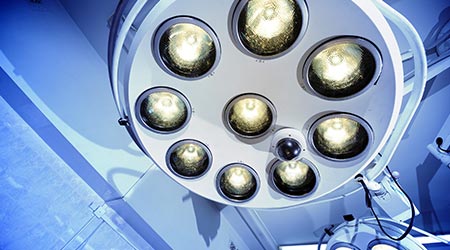The last two years have been challenging for the healthcare industry. Between the ongoing COVID-19 pandemic, staffing shortages, and employee burnout, hospitals and other healthcare facilities are looking for new ways to more effectively treat patients. Managers are looking to improve every aspect of healthcare facilities, and no equipment or surface is off limits.
Knowing the benefits that lighting technology can have, more hospitals are looking to increase their investments in the technology. In this manufacturer roundtable, Healthcare Facilities Today talks with lighting manufacturers about the reasons more healthcare facilities should be using these technologies.
Why should more healthcare facilities be using lighting technology? How can we scale this technology across smaller hospitals who do not have the same resources as other larger centers?
“While the initial investment with certain products can be high, the benefits of fewer people spending hours constantly disinfecting and performing other duties, as well as the typically long-life cycle of the bulbs, will often be an overwhelming win for the facility. Most smaller hospitals are a part of an integrated delivery network (IDN) or a group purchasing organization. Those organizations negotiate contracts for their members, so most would have access to the best pricing. If they are independent or in a smaller IDN, then most manufacturers and distributors should be able to offer terms or financing. In addition, many manufacturers have different levels of pricing for both products and services. That would ideally allow the smaller facility to get the best products for what they need at the best price.”
— Bill Mauzé, President, INVZBL
“UV-C light air disinfection technology is an engineering control that is proven effective and reliable for 24/7 operation. There are no harmful byproducts, and maintenance is easy with minimal ongoing costs. How can we scale this technology across smaller hospitals who do not have the same resources as other larger centers? UV-C light technology costs scale with the volume of buildings and/or number of rooms to disinfect. So typically, the installation cost for smaller hospitals will be less than it is for larger hospitals.”
— Jim McMahon, Vice President Sales Americas, Heraeus Noblelight America LL
“Healthcare facilities should be incorporating UV disinfection lighting solutions to make their visitors, personnel, and staff feel safer when they come to work. With progressions in technology for the far UV-C wavelengths, it is possible to future-proof spaces against the possibilities of future epidemics and pandemics. Pathogens and their variants do not develop a resistance to UV, unlike antibiotics and viral treatments. Far UVC wavelengths found with Care222 technology can continually treat the space, both when it is occupied and unoccupied, and can really be carried through every room in the healthcare facility, ranging from the patient room, over the nurse’s station, in the operating room, and into the waiting areas and will treat both air and surfaces.
UV light disinfection technology has a place in all different types of healthcare facilities, including hospitals, acute care facilities, senior living facilities, urgent cares, and even smaller doctor and dentist offices. Many believe that UV disinfection is an investment that is out of reach, but the reality is that most buildings and most owners now have the ability to incorporate UV disinfection solutions in select spaces that would benefit from viral and bacterial treatment the most. With better pathogen control, there is less concern about how many occupants are using a particular space. UV light disinfection technology provides an additional layer to existing cleaning and disinfection plans in a healthcare setting.
A common recommendation we like to give is, if your budget is not going allow for UV disinfection technology in every room, focus on locally treating spaces that either have the greatest level of human interaction – breakrooms, lunch areas, waiting rooms – or areas that have the highest touch surfaces – conference rooms over a table, patient rooms over the bed, operating rooms over the surgical table. Many think that they must incorporate UV disinfection to cover every square foot of a room, and that doesn’t necessarily need to happen. There are spaces that could really benefit from treating specific surfaces, such as operating room tables, patient beds, and communal restroom sinks.”
— Tommy Nichols, Architectural Sales Director, Acuity Brands
“Healthcare facility professionals and infection control preventionists can utilize germicidal-UV technologies to greatly reduce concentrations of pathogens in a highly reliable and cost-effective fashion. UV-C supplements infection-control protocols for disinfection, sterilization, and manual cleaning in healthcare settings such as ER waiting rooms, intensive care units, operating theaters, urgent care clinics. doctor and dental offices, nursing homes, and extended care facilities. In addition to its 24/7 operation of inactivating infectious pathogens, UV-C systems provide some level of protection when staffs do not or cannot follow protocols, or if emerging diseases sidestep existing protocols and when HVAC or room-pressurization systems are compromised. The UV-C wavelength can kill 99 percent or more of all microorganisms living on HVAC air ducts and evaporator coils, depending on UV-C intensity, length of exposure, UV-lamp placement, and lamp life cycle.”
— Dean Saputa, Vice President Sales, UV Resources
Mackenna Moralez is the assistant editor for Healthcare Facilities Today.

 Rethinking Strategies for Construction Success
Rethinking Strategies for Construction Success From Touchless to Total Performance: Healthcare Restroom Design Redefined
From Touchless to Total Performance: Healthcare Restroom Design Redefined New York State Approves $53M Construction Program at Niagara Falls Memorial Medical Center
New York State Approves $53M Construction Program at Niagara Falls Memorial Medical Center How Health Systems Are Rethinking Facilities Amid Margin Pressure
How Health Systems Are Rethinking Facilities Amid Margin Pressure Ground Broken on New Medical Office Building in Scottsdale, AZ
Ground Broken on New Medical Office Building in Scottsdale, AZ